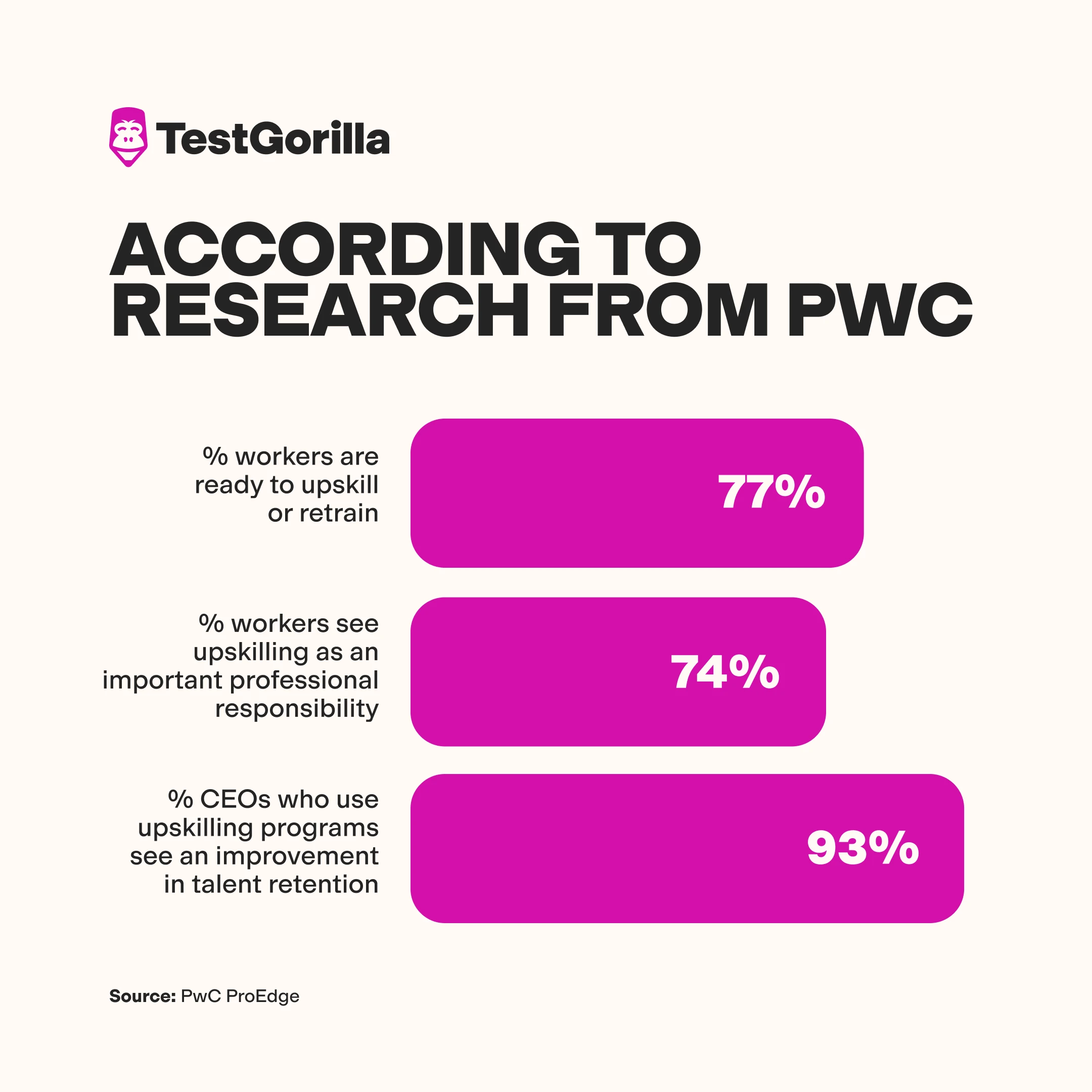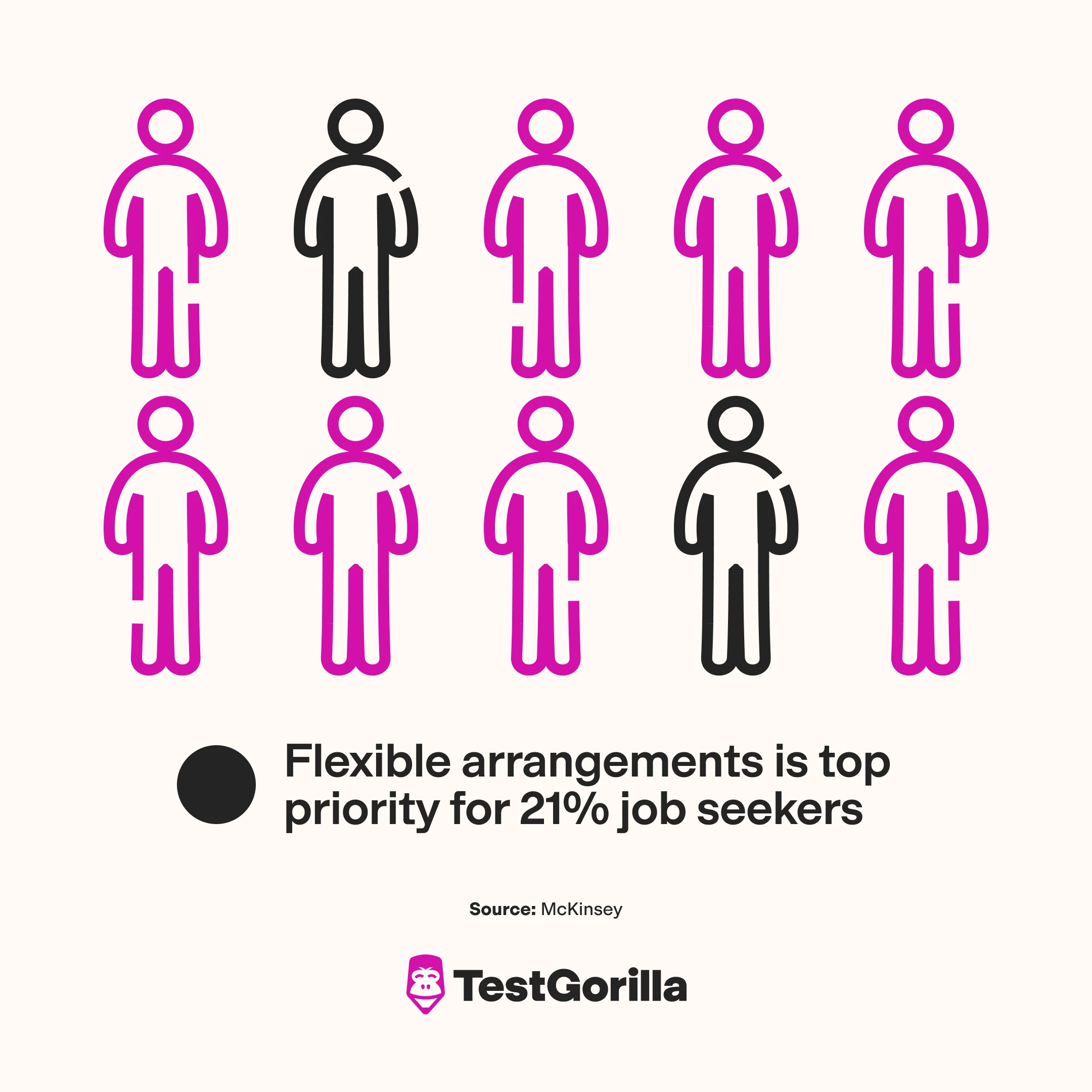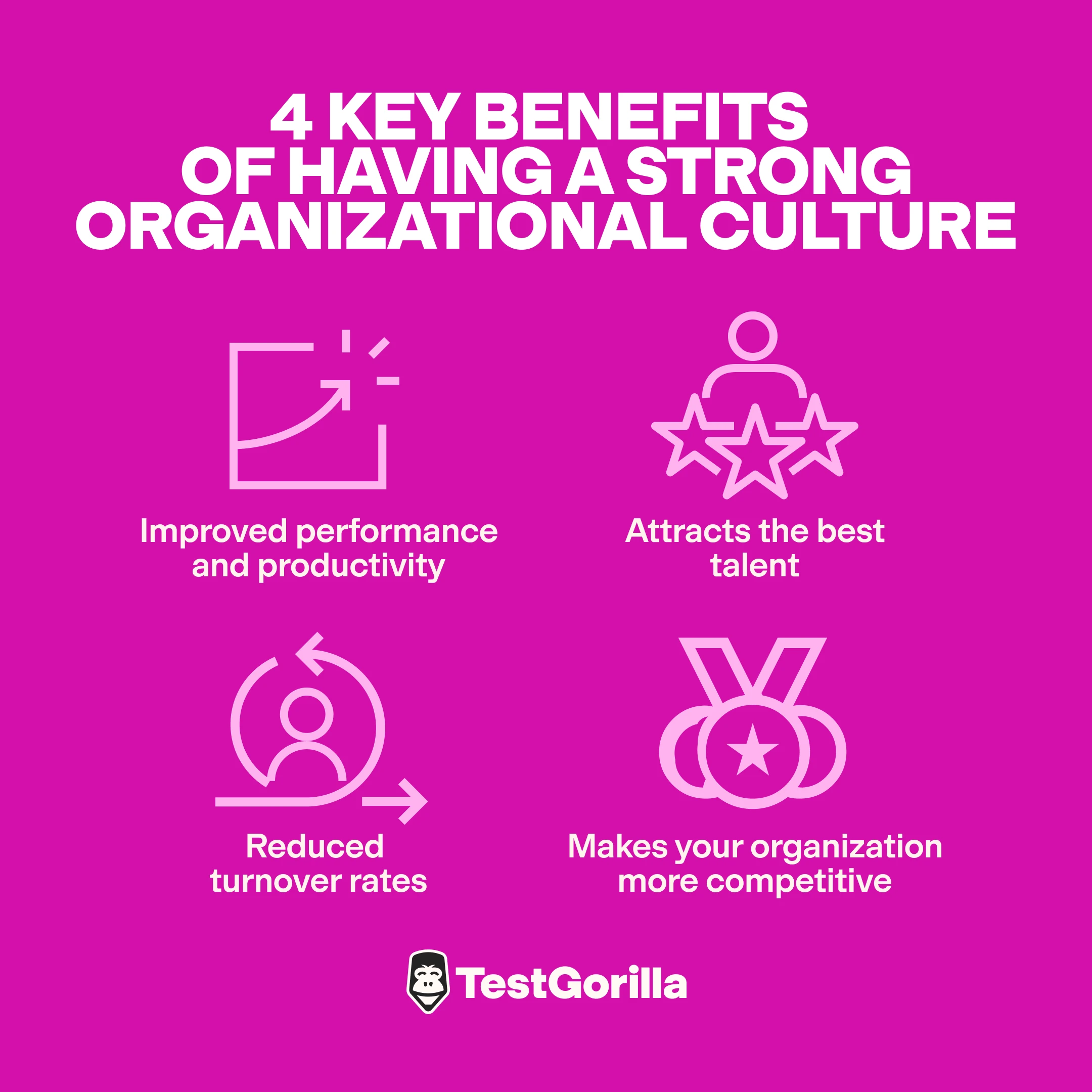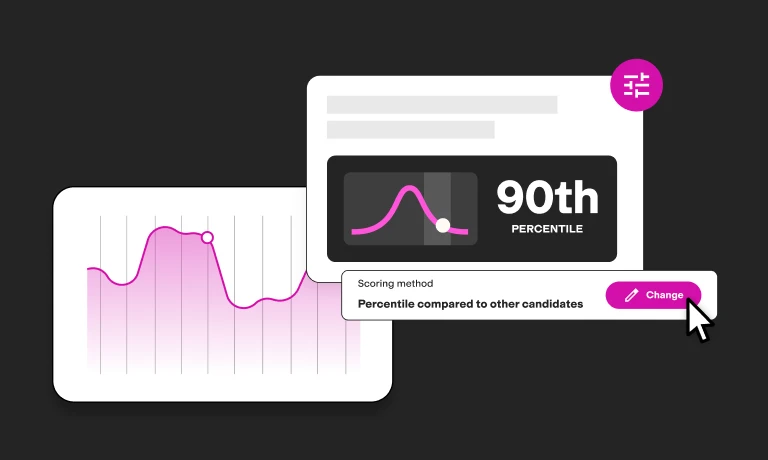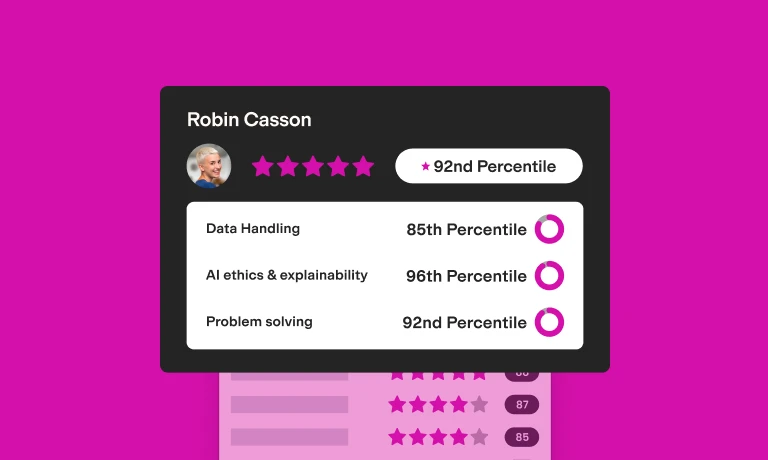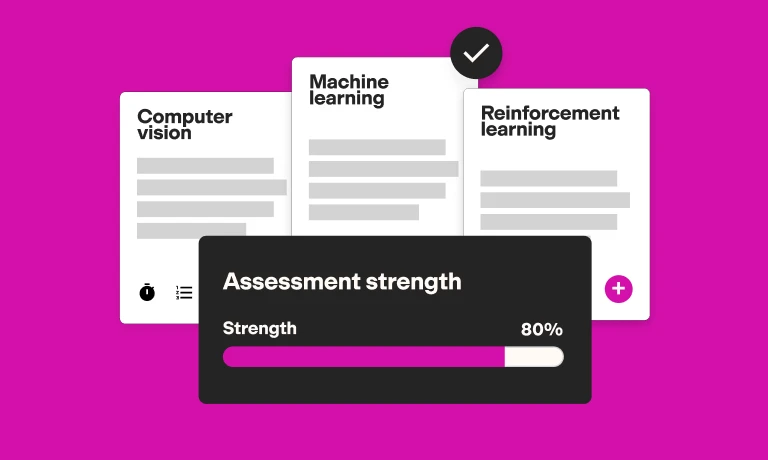It’s always a blow when an employee leaves.
Not only do you lose their knowledge and experience, but it can cost up to twice your employee’s salary to find a replacement.
But even on their last day, your exiting employees can be a vital resource for your company. They can provide insights into your organization’s weaknesses, showing you how to bolster employee retention in the future.
The right exit interview questions let you tap into that insight. When hiring a new employee, you use thorough skills testing to gather the information you need about their skills before bringing them on. It makes sense to take a similar approach when they leave, right?
In this post, we walk you through the employee exit interview one question at a time. Then we dig into what an exit interview is, why it matters, and how you can make it work for you.
Part 1: 14 exit interview questions to ask departing employees
Exit interviews can be sensitive for both you and your departing employee. To keep the conversation on track, you need to approach the interview with a clear plan.
A well-structured exit interview is helpful for both parties. It gives your departing employee an opportunity to share any issues they encountered and lets you gather valuable information to help your company improve.
These 14 questions are arranged in order, so your conversation flows as naturally as possible. Each one helps your company understand more about its processes, workflow, and culture – as well as the specifics of your employee’s departure.
Whenever you’re ready to schedule the interview, keep this exit interview template in your back pocket.
Exit interview questions at a glance
Question | Why ask? |
What led you to start searching for a new job? | Understand the broad-stroke reasons for the departure |
What did you like best and least about your job and this company? | Encourage constructive feedback about challenges your employee faced in the role |
Do you think your job has changed since you were hired? | Identify any necessary changes to the job description before hiring a replacement |
Do you feel you were given adequate support, resources, and tools to succeed in your job? | Learn how to create a more supportive, trustworthy work environment for remaining workers |
Do you feel you received enough training and upskilling opportunities? | Reveal any gaps in opportunities for employee growth within your company |
Do you feel that your contributions have been recognized and valued? | Understand how you can better celebrate your workers |
Were your working conditions flexible enough? | Pinpoint any staff concerns about work-life balance and flexible working options |
How would you describe the overall culture of our company? | Understand whether your goals for your company’s culture align with your employees’ experience |
Did you encounter any problematic company policies? | Uncover any day-to-day pain points in policy and workflow |
How was your overall experience working with your colleagues? | Verify whether your company is hiring teams that can work together effectively |
Did you have a good experience working with your manager? | Identify any issues within company management |
What do you think the company could have done differently to retain you? | Reveal problems within your company that may be damaging employee morale |
Would you consider returning to the company? | Get a better idea of what could encourage departing employees to bring their experience back to your company in the future |
Do you have any more suggestions for how we could improve as a company? | Encourage any additional feedback outside the scope of these questions |
1. What led you to start searching for a new job?
This is a broad-strokes, open-ended question, which makes it a great way to open an exit interview. It gives your employee scope to direct the conversation to their biggest concerns, enabling you to focus your conversation accordingly. While it isn’t relevant to all employees (particularly those who have been laid off or decided to retire), it’s a strong opening question in most situations.
Whether their answer focuses on what your company lacks or what other organizations offer that you don’t, you can get a useful early picture of your employee’s situation.
This question is especially useful if you’re facing high levels of voluntary turnover. Watch for patterns in the answers your departing employees give to this question. These patterns might point to specific things you could change within your company to limit the cost and consequences of losing your staff.
2. What did you like best and least about your job and this company?
The first part of this question invites positive feedback, which helps you to see what you are doing well. Even if they have serious reasons for leaving, most employees can still point to something they liked about working for your company.
That’s important information, too: If you’re doing something right, it’s important to know what it is and to stick with it.
The second part of the question gives your employee scope to raise any challenges they faced in the role they’re leaving. Whatever they tell you should form the basis of further discussion about what your company can do better.
3. Do you think your job has changed since you were hired?
The nature of any role can shift over time – and as an HR manager, you may not always be aware of it.
These changes are often totally normal, reflecting your company’s changing operational needs. But they sometimes point to other factors, such as understaffing or management issues, which may indicate larger problems within your company.
If your employee feels their role has changed since they started, it’s worth your while to get their perspective on that shift.
And regardless of the reasons the job might have changed, you need to understand the current shape of the role before you hire someone new to take it on. This question gives you important context to write a great job description and employee profile for whoever replaces your leaving employee.
4. Do you feel you were given adequate support, resources, and tools to succeed in your job?
Employees want to be able to trust their managers and senior leadership to support them at work.
So if your exiting employee doesn’t feel that they were well-supported in their role, you need to know about it. It points to a major area of potential improvement for your organization.
By asking for input on how you can do better, you acquire a valuable perspective on your company culture. If there’s a problem, your employee has probably thought about how it could be solved. Take advantage of that insight, and your remaining staff will reap the benefits.
5. Do you feel you received enough training and upskilling opportunities?
Opportunities for reskilling and upskilling are an increasingly big concern for people deciding where to work. According to research from PwC:[1]
77% of workers are ready to upskill or retrain
74% of workers see upskilling as an important professional responsibility
93% of CEOs who use upskilling programs see an improvement in talent retention
If your departing employee doesn’t feel they received enough opportunities to grow within your organization, you need to act on that valuable feedback. Offering more chances to train and upskill is an easy way to limit employee turnover.
6. Do you feel that your contributions have been recognized and valued?
Whatever we do, we all want to feel recognized and appreciated at work. Conversely, employees who don’t feel valued are likely to look elsewhere for opportunities.
If your employees are not feeling acknowledged, it can lead to morale issues, which generate turnover. And if your turnover problem gets out of hand, they lead to further problems with morale throughout your company – creating a vicious cycle.
Asking this question helps you to identify whether your company is doing enough to recognize its staff. If your feedback on this question is negative, it’s time to think harder about ways to show appreciation to your team members.
7. Were your working conditions flexible enough?
Since the pandemic, remote working has seen a major boom. But flexible working is about more than just remote work. It’s also about other benefits, including:
Paid time off
Schedule flexibility
Part-time work options
Scope for sabbaticals or career breaks
And it’s an increasingly important concern for employees. In a survey by McKinsey, 21% of respondents cited flexible working arrangements as a top priority when looking for a new job.
If your employees aren’t getting what they need in terms of flexibility from your company, they’re likely to look elsewhere. Understanding what your exiting employees want from their work arrangements helps you to offer your current staff a better deal.
8. How would you describe the overall culture of our company?
Understanding your company culture enables you to hire more efficiently and establish common ground with your employees. The shared values of a company’s culture are foundational to an efficient team.
There are four key benefits of having a strong organizational culture:
Improves employee performance and productivity
Attracts the best talent
Reduces turnover rates and assists in retaining employees
Makes your organization more competitive on the whole
But devising a company culture is very different from implementing it in practice. Your team members, who experience your company culture first-hand every day, can bring a fresh perspective to your understanding of your company culture.
If the answers you receive when you ask this question don’t align with your goals for your company culture, it may be time to reevaluate your approach.
9. Did you encounter any problematic company policies?
Like company culture, policies can look very different depending on your angle of approach. A policy that makes perfect sense to managers may cause serious difficulties for the employees who have to navigate it every day.
This question helps you dig into the specific difficulties your employee encountered in their post. Whether a problematic policy impacted the day-to-day logistics of their work or their overall experience of the company, you benefit from understanding what went wrong and why.
Answers to this question provide constructive feedback on how to fix persistent problems at work. The information you glean here could save your current employees real frustration while improving overall productivity as a bonus.
10. How was your overall experience working with your colleagues?
Most full-time workers spend more time with their colleagues than with their families. It’s always better for a company to build teams that work well together – it leads to better employee engagement and higher productivity for everyone.[2]
But on the other side of that coin, teams that don’t work well together can torpedo an employee’s morale.
If your departing employee mentions difficulties in working with their colleagues, you should consider changing your hiring approach. With the right tests, like the popular 16 Types Personalities test, you can gauge who’ll get along well with your teams and avoid this problem.
11. Did you have a good experience working with your manager?
A recent Flexjobs study shows that poor management is the number three reason why people leave their jobs. It’s an indicator of how crucial it is for employees and managers to work well together – and how a bad relationship with a manager sours the job experience.
While that bad relationship can come down to something as innocuous as a mismatch of leadership styles, it may also point to a larger problem with the manager’s approach.
Asking this question of all your departing employees gives you the data you need to determine whether your company has a management problem. If multiple employees working with the same manager are quitting, it’s worth examining that manager’s performance more closely.
12. What do you think the company could have done differently to retain you?
The ultimate goal of these questions is to learn what you could have done better to retain your employee. This specific question doesn’t apply to all departing employees – it isn’t worth asking how you could have retained an employee who is retiring, for example. But in most cases, this question gets right to the point of the exit interview.
If you followed this guide from the beginning, you have probably already asked what prompted your employee to start looking elsewhere. This question is more focused on potential changes than on root causes. It asks directly for feedback and suggestions that may benefit your remaining staff.
Because this question is so general, it often helps to target issues that are harder to spot at a glance. A salary differential between your company and a competitor is an obvious reason for an employee to leave, but concerns like inefficient processes or unresponsive managers can be harder to pin down.
13. Would you consider returning to the company?
Believe it or not, not all your departing employees are gone for good. Visier offers some key stats on returning employees:
29% of newly hired employees were rehires in 2020
25% of returning employees were high performers when previously employed by their companies
Returning employers generally come back to their former employers after one year away
So-called “boomerang employees” come with real advantages. They already know your company and have valuable experience with how you work. This means they take less time and money to onboard.
If there are factors that would encourage your exiting employees to return, it’s worthwhile to know what they are. Knowing these factors helps you out in the long run.
14. Do you have any more suggestions for how we could improve as a company?
No matter how much you plan your exit interview, there’s always the risk that you won’t ask the right question to prompt your employee to talk about their experience. If you don’t leave them room to share additional comments, you could miss out on vital information that could help to improve your company.
This open-ended final question is designed to cover any bases you may have missed.
Part 2: A deep dive into exit interviews
Knowing the best exit interview questions to ask is only half the battle. To get the most out of an exit interview, it’s important to understand exactly how it benefits your company.
This guide to the best practices for exit interviews offers a path to meaningful insights about your workplace. You can use these for continuous improvement so your organization stays competitive when it comes to recruiting top talent.
In this section, we go over why exit interviews matter. Then we delve into the best ways to make them work for you so you learn as much as possible and have the greatest scope to improve your practices in the future.
What is an exit interview?
An exit interview is a 1:1 meeting between an employee and a human resources professional. It’s an opportunity to ask questions about your worker’s decision to leave. Even better, it’s a chance to learn from their experiences of your company – good or bad – so you can continue to develop as an organization.
An exit interview should:
Formally end the relationship between employer and employee in a constructive way
Provide information about your employee’s experience of the company, its culture, its management, and their team
Help you to understand your employee’s reasons for leaving
Give you the tools to identify areas for improvement within your organization
Why are exit interviews important?
Why offer an exit interview? | How does it help your organization? |
Understand why employees leave | Provides information on how to improve employee experience, assisting with employee retention in the future |
Give employees a platform to raise issues | Establishes a culture of openness and trust, reducing turnover |
Gauge your company culture | Helps you to understand how to address any cultural issues within your organization |
Part on good terms with exiting employees | Reduces the risk of employees speaking negatively about your organization after leaving |
7 best practices for gaining maximum insight from exit interviews
Beyond asking the right questions, you must approach the exit interview process with sensitivity and care. Handling this gracefully increases your chances of gaining meaningful, honest feedback from your employees.
Follow these steps, and you’ll see a real improvement in the quality of the data your exit interviews yield.
Exit interview best practices at a glance
What to do | Why do it? |
Get the timing right | Ensure the exit interview acts as an endpoint on your employee’s experience with your company |
Have a neutral party conduct the interview | Give your employee space to speak more frankly |
Be aware of your employee’s feelings | Create a positive final impression of your company for your exiting employee |
Gather consistent data by asking standardized questions | Improve the quality of your exit interview data over time |
Use the 5 Whys technique to dig into your employee’s answers | Identify the root causes of issues your exiting employee faced at work |
Reassure all employees that their feedback is confidential and anonymous | Encourage your employee to be more forthcoming about their experiences |
Gather feedback proactively before your employees leave | Foster a workplace culture of openness, transparency, and constant improvement |
1. Get the timing right
You should schedule exit interviews after your employee has told you they plan to leave, but before they go anywhere. This means the exit interview acts as a definitive capstone on their experience with your organization.
This is true even for remote employees. Although you don’t need to worry about them being inaccessible in person or face-to-face after they leave, you should still aim to give them a coherent, orderly offboarding process.
That way, you can be sure that your company treats its employees fairly and professionally to the end of their time with you.
2. Have a neutral party conduct the interview
Your employee may have a fraught relationship with their manager, especially if they’ve been laid off or fired. Even if that’s not the case, it’s important to remember that they probably worked very closely with their manager. They may not feel comfortable being totally honest about their experiences when that manager tries to collect exit interview feedback.
Having an HR professional or coach conduct the exit interview leaves more room for your employee to speak frankly. This improves the quality (and accuracy) of the data you gather.
3. Be aware of your employee’s feelings
The average person spends 1,936 hours at work every year. Even if they’ve voluntarily decided to leave, your employees might find it challenging to move on from a place where they’ve invested so much time.
Be aware that your employees may have difficulty transitioning out of their workplace, and approach the exit interview sensitively. Try to use non-judgmental language, give people space to speak openly, and respect the answers they give you.
4. Gather consistent data by asking standardized questions
It’s a known fact in the scientific community that standardized measures yield more reliable results. The same is true of interview questions.
Whether hiring new employees or offboarding your existing staff, structured interviews help you gather the most useful information. They also help you collate responses to your standardized questions more easily, so you can spot any patterns that emerge.
Don’t be afraid to follow up on the answers you get (the next point shows you an effective way to do that without losing focus). But sticking to your overarching structure gives you a clearer picture of your employee’s experience than a wide-ranging conversation.
5. Use the five whys technique to dig into your employee’s answers
One-size-fits-all questions won’t always yield the in-depth results you need. Techniques like the five whys help you go beyond the superficial and get to the heart of any issues your employees raise.
The steps to a five whys analysis are as follows:
Begin by discussing a specific problem
Ask why the problem happened
Ask why again: What caused the event that caused the problem?
Keep asking why until you have found the root cause of the initial problem
It typically takes five iterations of “why” to reveal the root cause, hence the name.
Use the data this process yields to pinpoint the structural issues that may create problems for your employees. From there, you can work on rectifying them.
6. Reassure all employees that their feedback is confidential and anonymous
Speaking up about problems in the workplace can be challenging for employees. Even at the best of times, it’s hard to feel as though you’re complaining. And depending on your company culture, your team members may be worried about pushback or even reprisal from management.
But by reassuring your employees that you take their feedback seriously and respectfully, you encourage them to be more forthcoming about their experiences. The safety net of confidentiality ultimately improves the quality of your data.
7. Gather feedback proactively before your employees leave
If you wait until the exit interview to gather feedback from your employees, it could point to a problem with your organization’s culture. Ideally, your employees should feel safe to share their input before they reach the point of leaving.
Fostering a culture of transparency, respect, and feedback in your workplace helps your employees to feel more psychologically safe. This ensures that they feel comfortable raising issues before they become more serious problems.
This approach limits employee turnover and may even reduce your reliance on exit interviews in the long run.
The best insights on HR and recruitment, delivered to your inbox.
Biweekly updates. No spam. Unsubscribe any time.
Use exit interviews to improve your hiring processes
By asking the right exit interview questions, your organization can turn the loss of an employee into a valuable resource for future hiring and retention.
A clear structure and an emotionally intelligent, sympathetic approach to the exit interview enable you to learn much more from your employees. Using the techniques you’ve learned in this guide, you can gather useful, honest data and identify patterns that will help your company grow and improve.
Learn how to maintain organizational stability when an employee leaves with our succession planning guide.
Or use the Leadership and People Management test to assess potential candidates for succession.
Sources
“Upskilling’s impact on learning, talent retention and talent acquisition”. (n.d.). PwC ProEdge. Retrieved March 6, 2023. https://proedge.pwc.com/upskilling-and-talent-strategies
Gurchiek, Kathy. (December 16, 2014). “Survey: Workplace Friends Important Retention Factor”. SHRM. Retrieved March 6, 2023. https://www.shrm.org/resourcesandtools/hr-topics/employee-relations/pages/workplace-friendships.aspx
Related posts
You've scrolled this far
Why not try TestGorilla for free, and see what happens when you put skills first.


